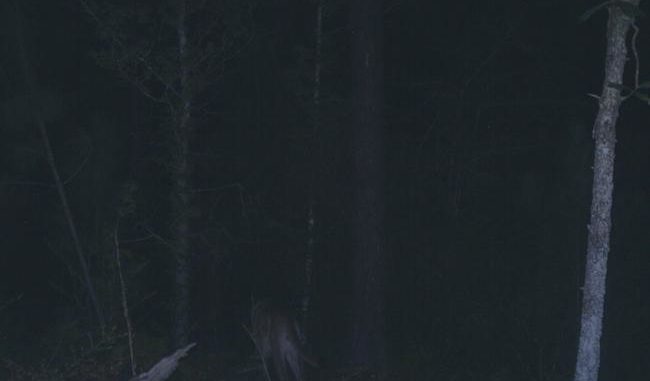
Trail cam photo taken in Vernon Parish in mid August.
A trail cam captured an image of a cougar in Vernon Parish earlier this month, the Louisiana Department of Wildlife and Fisheries confirmed yesterday (Aug. 29).
The image captured on Aug. 31 by a camera set up by a private citizen, who then submitted it to LDWF for investigation.
LDWF Large Carnivore Program Manager Maria Davidson and biologist Brandon Wear conducted a site investigation that confirmed the authenticity of the photograph.
“It is quite possible for this animal to be captured on other trail cameras placed at deer bait sites,” Davidson said. “Deer are the primary prey item for cougars; therefore, they are drawn to areas where deer congregate.”
However, Davidson stopped short of saying it was evidence there are wild cougars roaming Louisiana’s woods.
“It is impossible to determine if the animal in the photograph is a wild, free-ranging cougar, or an escaped captive,” Davidson added. “Although it is illegal to own a cougar in Louisiana, it is possible that there are some illegally held ’pets’ in the state.”
The agency said it is unlikely this cougar will remain in any one area longer than it would take to consume a kill because cougars do not prefer to eat spoiled meat and will move on as soon as the Louisiana heat and humidity take its toll on the kill.
LDWF has documented several other occurrences since 2002.
The first cougar sighting was in 2002 by an employee at Lake Fausse Point State Park. That sighting was later confirmed with DNA analysis from scat found at the site.
Three trail camera photos also were taken of a cougar in Winn, Vernon and Allen parishes in 2008.
Subsequently on Nov. 30, 2008, a cougar was shot and killed in a neighborhood by Bossier City Police Department.
Although LDWF receives numerous calls about black panthers, there has never been a documented case of a black cougar anywhere in North America. The mountain lion – also known as cougars, panthers and pumas – ranges in color from lighter tan to brownish grey.
The only species of big cats that are black are the jaguar and leopard. Jaguars are native to South America and leopards are native to Africa. Both species can occur as spotted or black, although in both cases the spotted variety is much more common.
The vast majority of these reports received by LDWF cannot be verified due to the very nature of a sighting. Many of the calls are determined to be cases of mistaken identity, with dog tracks making up the majority of the evidence submitted by those reporting cougar sightings.
Other animals commonly mistaken for cougars are bobcats and house cats, usually seen from a distance or in varying shades of light.
The significant lack of physical evidence indicates that Louisiana does not have an established, breeding population of cougars. In states that have verified small populations of cougars, physical evidence can readily be found in the form of tracks, cached deer kills, scat and road kills.
The recent sightings of cougars in Louisiana are believed to be young animals dispersing from existing populations. An expanding population in Texas can produce dispersing individual cougars that move into suitable habitat in Louisiana. Young males are known to disperse from their birthplace and travel hundreds of miles seeking their own territories.
Cougars are protected in Louisiana under state and federal law. Penalties for taking a cougar in Louisiana may include up to one year in jail and/or a $100,000 fine.
Anyone with any information regarding the taking of a cougar should call the Operation Game Thief hotline at 800.442.2511. Callers may remain anonymous and may receive a cash reward.
To report verifiable sightings of cougars with physical evidence such as photos, tracks and/or scat, please call your nearest LDWF Field Office at:
• Minden – 318.371.3050
• Monroe – 318.343.4044
• Pineville – 318.487.5885
• Lake Charles – 337.491.2575
• Opelousas – 337.948.0255
• Hammond – 985.543.4779